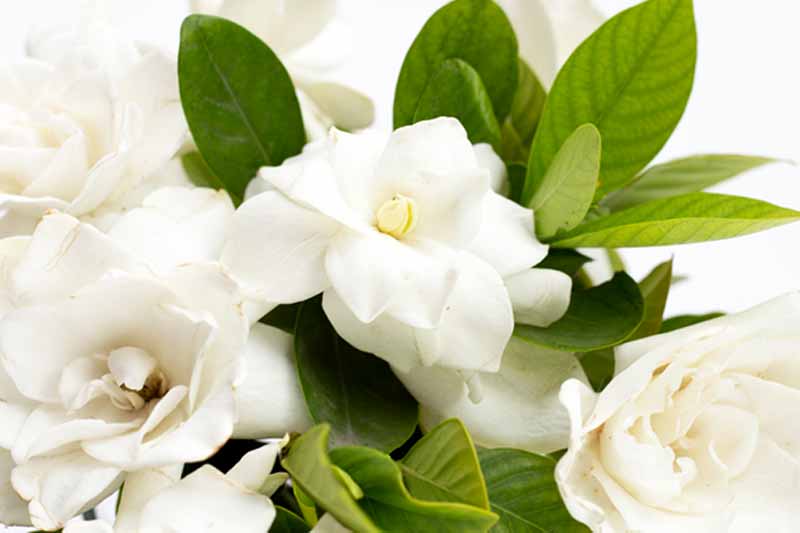Quick Facts
Botanical Name: Gardenia jasminoides
Family Name: Rubiacea
Common Name: Gardenia radicans,G grandiflora,G augusta
Part Used: Flowering tops
Specific Gravity: 0.8100 to 0.82800 @ 20°C
Optical Rotation: 1.862 to + 1.876 @ 20°C
Refractive Index: 1.450 to 1.956 @ 20°C
Gardenia is an evergreen bush type small tree which belongs to the botanical family of Rubiacea and the botanical name is Gardenia jasminoides. The plants grow to between two and five feet tall and have glossy light green leaves. The flowers are bright white in colour and sometimes it has various colours also. The gardenia plants are grown abundantly in Japan and China and in the United States it grows well in the south and west. It is an original native of the tropic and subtropical regions and there are 43 different species of Gardenia. It is also called the White angle in some places and the flowers are used to scent teas.
Extraction Process
Gardenia oil is extracted by the enfleurage method. In this method the extraction of oil and perfumes from flowers are done using odourless animal and vegetable fat. Gardenia oil has a sweet floral scent and this extraction method of the petal, which is the most fragrant part, is soaked in fat. The fat used is placed in alcohol to dissolve. The whole procedure is labour intensive and it takes huge quantities of flower petals to make just one millilitre of oil. Even after the processing of flowers the aroma stands strong in the oil.

Blends Well With
Gardenia oil blends well with cinnamon leaf, clove bud, jasmine, neroli, rose otto, tuberose, citrus oils and ylang ylang essential oils. It contain osmically balanced notes with top, middle and base notes and can be applied alone as a perfume. The aroma is rich, heady, sweet and floral and have antiseptic and fragrant properties. The main chemical components of gardenica oil are benzyl acetate with phenyl acetate, linalool, linalyl acetate, terpineol, methyl anthranilate etc. Gardenia jasminoides was first introduced to the Western world from Cape Colony in Africa and the name was derived because of its large white flowers which have the scent of jasmine. It is one of the most precious oils in the world and is known for its blissful odour and fragrance.
The flower of gardenia is delicate in nature and it cannot be distilled like other essential oils because of this. The perfume made out of gardenia is enjoyed as a single flower because of its rich, warm, heady floral aroma and aroma is osmically balanced like Carnation and Lavender. Gardenia oil is popular in aromatherapy treatment because of the sweet and strong odour.
romatherapy is one of the popular alternative healing systems today and it has many different types of aromatic compounds. These compounds assist to cure different kinds of ailments. Gardenia is a concentrated hydrophobic liquid and it is the main compound of the most popular aroma compounds used in aromatherapy.
Medicinal Properties
Gardenia oil has many medicinal properties and is used for treating infections, jaundice, anxiety, blood clotting, insomnia, menopausal imbalances, cooling the blood, bladder infections, sedative, anti-inflammatory, reduction of swelling and tumours etc. It is good for interstitial cystitis and is good as an antibacterial, antioxidant, sinus infection, stress, headaches, nervous tension and skin disorders.
Chinese traditional herbal medicines commonly use Gardenia oil to treat infections like bladder infection, abscesses, jaundice and blood in the urine, sputum or stool. Because of its rare and wonderful fragrance it is widely used in candles and its strong aroma is present whether the candle is lit or not. Pot-pourri is another popular use for gardenia oil. The dried flowers, pine cones and other dry components absorb the flowery scent of gardenia and you can keep refreshing the pot-pourri by adding few drops as needed. By adding a few drops of gardenia oil to your soap you can have a relaxing bath and shower and make it more enjoyable.
Strong Flowery Aroma
Gardenia oil when added to perfumes offers a strong flowery aroma and it can be used for inhalation from hot compress, hot water steam or diffuser. It is ideal if you stick to only ten drops for respiratory, headaches and sinusitis. Gardenia oil can be added to bath and essential oils mixed with salt or an emulsifier to assist in the dispersing of the oil. These baths with gardenia oil is good for skin problems, respiratory symptoms, circulatory issues, stress, nervous tension, insomnia, muscular pain and menstrual pain etc. Gardenia oil is ideal for a stress relieving healthy massage and this can be done by adding a few drops of the oil to a moisturising lotion. Make sure that the lotion is not is applied cold and if it is cold make sure to rub the hands together to generate heat before putting the lotion in the hands for the massage.
Direct palm inhalation is a quick and easy method when needed and this can be done by taking one or two drops of Gardenia oil on the palm and rubbed gently together before inhaling. Take a soft cloth and soak in the solution of ten drops of Gardenia oil and four ounces of hot water. The compress can be applied to the affected area for a few minutes and then soaked and applied again. The compress is ideal for problems like muscle aches, bruises, wounds, skin issues and dysmenorrhea.
For Facial Steam
Gardenia oil can be used as a facial steam by adding 5 drops of oil into hot water and a towel. The towel can be placed over the inhaler and you can allow the steam to hit the face and inhale. This is good for headaches, sinusitis and facial skin health. The oil is not recommended for use by pregnant women or children. It is always better to do a patch test before using regularly because some oils may cause irritation or allergic reaction to sensitive skin.
In Chinese herbal medicine it is called "zhi zi " and gardenia is known for its ability to calm irritation, cooling blood and clearing away heat from the body. It reduces swelling and moving stagnant blood stored in one place due to trauma. Gardenia is good haemostatic agent and also effective in treating injuries to muscles, joints and tendons





